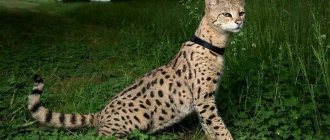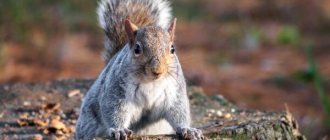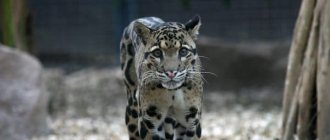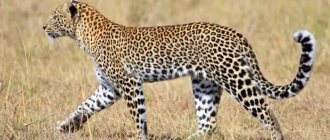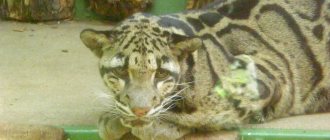- Wild animals
- >>
- Mammals
The Far Eastern leopard is rightfully called one of the most beautiful predators of the cat family. It is the rarest of all subspecies. The name is translated from Latin as “spotted lion.” Along with its closest large relatives - tigers, lions, jaguars, the leopard belongs to the genus "panther".
Origin of the species and description
Photo: Far Eastern leopard
Ancient people believed that the leopard comes from the lion and the panther, being their hybrid. This is reflected in its name. Another name, “leopard,” comes from the language of the ancient Hatti people. The epithet "Far Eastern" is a reference to the geographical location of the animal's habitat.
The first mention of the Far Eastern leopard appeared in 1637 in a treaty between Korea and China. It said that Korea was supposed to supply the Chinese with 100 to 142 skins of these beautiful animals every year. The German scientist Schlegel elevated the Far Eastern leopard into a separate species in 1857.
Video: Far Eastern leopard
Research at the molecular genetic level shows that the relationship between representatives of the Panther genus is very close. The direct ancestor of the leopard originated in Asia, and soon after that it migrated to Africa and populated its territories. The found remains of the leopard date back 2-3.5 million years.
Based on genetic data, it was established that the ancestor of the Far Eastern (Amur) leopard is the North Chinese subspecies. The modern leopard, according to the study, arose approximately 400-800 thousand years ago, and after 170-300 thousand it spread to Asia.
Currently, there are about 30 individuals of this species in the wild and they all live in the southwest of the Russian Far East, slightly north of the 45th parallel, although at the beginning of the 20th century the range covered the Korean Peninsula, China, the Ussuri and Amur regions .
Distribution area
The habitat of leopards is very wide. However, their numbers in many regions are extremely small. A wide population is distributed throughout Africa, as well as in Asia and some regions of the Arabian Peninsula. Black representatives can be found on the island of Java and Malacca.
Animals prefer vast forest spaces as a habitat. Tropical and deciduous forests, river thickets and mountain slopes are widely inhabited. Some subspecies are found in savannas, steppes and deserts. It is important for them to have some kind of shelter in which there is a sufficient amount of food and the absence of threats from people.
Appearance and features
Photo: Far Eastern leopard animal
Leopards are considered one of the most beautiful cats in the world, and the Far Eastern subspecies is the best of its kind. Experts often compare it to a snow leopard.
These slender animals have the following characteristics:
- Body length - from 107 to 138 cm;
- Tail length - from 81 to 91 cm;
- The weight of females is up to 50 kg;
- The weight of males is up to 70 kg.
In summer, the length of the coat is short and often does not exceed 2.5 cm. In winter, it becomes thicker, more luxuriant and grows up to 5-6 cm. Light yellow, reddish and yellowish-golden shades predominate in the winter color. In summer, the fur becomes brighter.
Multiple black spots or rings in the form of rosettes are scattered throughout the body. On the sides they reach dimensions of 5x5 cm. The front part of the muzzle is not framed by spots. There are dark markings near the whiskers and at the corners of the mouth. The forehead, cheeks and neck are covered with small spots. The back of the ears is black.
Interesting fact: The main function of color is camouflage. Thanks to it, natural enemies of animals cannot accurately determine their size, the impression of contours becomes deceptive and leopards become less noticeable against the background of the natural environment.
This color is called protective. Similar to human fingerprints, leopards' patterns are also unique, allowing individuals to be identified. The head is round and relatively small. The front part is slightly elongated. The ears are set wide and have a rounded shape.
The eyes are small with a round pupil. Vibrissae can be black, white or a mixed type and reach 11 cm in length. 30 long and sharp teeth. The tongue has tubercles covered with hardened epithelium, which allow meat to be picked from bones and help with washing.
Northern Chinese
North China - Northern China is the habitat. It has the longest fur with spots similar to those of a jaguar.
Where does the Far Eastern leopard live?
Photo: Far Eastern Amur leopard
These wild cats adapt well to any terrain, so they can live in any natural conditions. At the same time, they avoid populated areas and places that people often visit.
Criteria for choosing a place of residence:
- rock formations with ledges, cliffs and outcrops;
- gentle and steep slopes with cedar and oak forests;
- roe deer population exceeding 10 individuals per 10 square kilometers;
- presence of other ungulates.
The best option for choosing a habitat is the middle and end of the water stream flowing into the Amur Bay and the area of the Razdolnaya River. This area extends over 3 thousand square kilometers, the altitude above sea level is 700 meters.
The abundance of ungulates in this territory is a favorable condition for the settlement of predators in this area, as well as uneven terrain, slight snow cover in winter and coniferous-deciduous forests in which black fir and Korean cedar grow.
In the 20th century, leopards lived in southeastern Russia, the Korean Peninsula and northeastern China. Due to human encroachment into their range, the latter was divided into 3 separate areas, which contributed to the creation of 3 isolated populations. Now leopards live in the mountainous and forested area between Russia, China and the DPRK with a length of 10 thousand square kilometers.
Habitats
The most densely populated areas where leopards live are forests and savannas. However, they give their choice to the trees.
Note!
Car hammock for dogs. What it is?- Removal and cremation of animals
Cynologists - who are they?
What does the Far Eastern leopard eat?
Photo: Far Eastern leopard red book
The most active hunting hours are during the twilight hours and the first half of the night. In cloudy weather in winter, this can also happen during the day. They always hunt alone. Watching the prey from ambush, they creep up to it at 5-10 meters and with quick jumps overtake the prey, clinging to its throat.
If the prey was particularly large, leopards live near it for a week, protecting it from other predators. If a person approaches the carcass, wild cats will not attack or show aggression, but will simply return to the prey when the people leave.
Leopards are unpretentious when it comes to food and will eat everything they can catch. And it doesn’t matter what size the victim is.
It can be:
- young wild boars;
- roe deer;
- musk deer;
- spotted deer;
- hares;
- badgers;
- pheasants;
- insects;
- wapiti;
- birds.
Interesting fact: This type of leopard loves to eat dogs. Therefore, when entering the protected areas of the national park, there will definitely be a warning: “entry with dogs is prohibited.”
On average, leopards need one adult ungulate for several days. They can stretch out their meals for up to two weeks. If the population of ungulates is insufficient, the interval between their capture can be up to 25 days; the rest of the time, cats can snack on small animals.
To cleanse the stomach of hair (mostly its own, swallowed while washing), predators eat grass and cereal plants. Their feces contain up to 7.6% of plant residues that can cleanse the gastrointestinal tract.
Nutrition
Leopards are absolutely predatory animals. They feed on a variety of roe deer, antelope and deer. Hunting for their prey is organized near bodies of water. In addition to artiodactyls, leopards can feed on the carcasses of hares, birds and some monkeys. During periods of lack of food, they do not hesitate to eat carrion.
Leopards tend to steal food from each other, since it can stay in the territory of another predator for a long time. As a rule, their shelters are located in root hollows of trees, on scattered stones and in rock overhangs.
Features of character and lifestyle
Photo: Far Eastern leopard
Being solitary by nature, Far Eastern leopards settle in separate territories, the area of which for males reaches 238-315 square kilometers, the maximum recorded is 509, and for females it is usually 5 times less - 108-127 square kilometers.
They do not leave the chosen area of their habitat for many years. Both in summer and winter they use the same paths and shelters for their offspring. The smallest territory is occupied by a female who has recently given birth. It is no more than 10 square kilometers. After a year, the territory increases to 40 square kilometers, and after that to 120.
The areas of different individuals may have common boundaries, and leopards may use the same mountain path together. Only the central part of the territory is zealously guarded, but not its cordons. Young males can hunt with impunity in someone else's area until they begin to mark it.
Most encounters are limited to threatening postures and growling. But situations are also possible when a weaker male dies in battle. The areas of females also do not overlap. Males' territories may overlap with 2-3 adult females.
Far Eastern leopards mainly mark not the cordons of their territories, but their central parts, scratching the bark of trees, loosening the soil and snow, marking territories with urine and excrement, and leaving traces. In most cases these are combined tags.
Interesting fact: The Far Eastern leopard subspecies is the most peaceful of its kind. In the entire history of their existence, not a single case of attack on a person has been recorded.
Western Asian
The Western Asian is the largest of the leopard subspecies. It is also called “Persian” or “Caucasian”. Mainly lives in Iran, but is also represented on the territory of the Russian Federation, where it was introduced. It has dark and light colors.
Social structure and reproduction
Photo: Far Eastern leopard cub
Amur leopards reach readiness to breed at 2.5-3 years. In females this happens a little earlier. Mating season usually occurs in the second half of winter. Pregnancy in females occurs once every 3 years and lasts 95-105 days. There can be from 1 to 5 cubs in a litter, more often 2-3.
Like ordinary cats, the mating period is accompanied by eerie screams, although leopards are usually silent and voice quite rarely. The greatest interest is noted in females whose kittens are in adolescence, when it is time to become independent. Dens for babies are usually set up in crevices or caves.
Kittens are born weighing 400-500 grams, with thick, spotted fur. After 9 days their eyes open. After a few more days they begin to crawl, and after a month they run well. By 2 months they leave the den and explore the territory with their mother. At the age of six months, babies can no longer follow their mother, but walk parallel to her.
From 6-9 weeks, the cubs begin to eat meat, but the mother still continues to feed them milk. At about 8 months, young cats master independent hunting. At the age of 12-14 months, the brood breaks up, but leopards can remain a group much longer, even after the birth of the next offspring.
Ceylonese
Ceylon - found only in Sri Lanka. The appearance is similar to the Indian one, but smaller in size. The coat is yellowish-brown or rusty yellow.
Natural enemies of Far Eastern leopards
Photo: Animal Far Eastern leopard
Other animals do not pose a particular danger to leopards and do not pose food competition. Leopards may be afraid of dogs, as hunters, and wolves, since they are pack animals. But, since the numbers of both in these areas are very small, there are no stumbling blocks between these animals and they do not influence each other in any way.
There is a popular belief that tigers can be enemies of leopards, but this is wrong. The Far Eastern leopard and the Amur tiger can easily coexist peacefully with each other. If a tiger tries to attack its relative, he can easily hide in a tree.
Competition due to hunting among these animals is also unlikely, because they both hunt sika deer, and their numbers in those places are very high and increase every year. The common lynx also poses no threat to leopards.
There is no food competition between leopards and the Himalayan bear, and their relationship is not hostile. Collisions can only arise due to the search for shelters of females with a brood. Experts have not yet established who has priority in choosing a den.
Among the scavengers, crows, bald eagles, golden eagles, and black vultures can feast on the prey of wild cats. Smaller remains can go to tits, jays, and magpies. But, one way or another, they are not considered to be food competitors of leopards. Foxes and raccoon dogs can finish eating a leopard if they know that it will not return to the prey.
Interesting Facts
A female leopard keeps her male cubs with her for much longer. They live with their mother for a couple of months longer than girls.
African tribal leaders usually wear leopard skin. This instills fear in their enemies. Since this skin indicates that they have all the qualities of this beast, grace, strength and power.
The predator from the genus of seals is called the leopard seal because it has the same spotted coloring and is a good hunter.
In medieval heraldry, a hybrid of a leopard and a camel was mentioned. This image was the body of a cat with the head of a giraffe with two horns. This animal was a symbol of zeal and courage.
The statement that the white leopard (snow leopard) is a light-colored leopard is erroneous. The white leopard belongs to the genus of mammals and is called the snow leopard.
Population and species status
Photo: Far Eastern Amur leopard
In the entire history of observation of the Far Eastern leopard, it is known that its subspecies has never been numerous. Data from previous years on the number of individuals characterize the leopard as a typical predator, but small in number for the Far East. In 1870, there were mentions of the appearance of cats in the Ussuri region, but there were even fewer of them than Amur tigers.
The main reasons for the decrease in numbers are:
- Poaching;
- Fragmentation of the habitat, construction of highways, deforestation, frequent fires;
- Reduction in food supply due to the extermination of ungulates;
- Inbreeding leads to depletion and poverty of genetic material.
In 1971-1973, there were approximately 45 individuals in the Primorsky Territory, and only 25-30 leopards were permanent residents, the rest were newcomers from the DPRK. In 1976, about 30-36 animals remained, of which 15 were permanent residents. Based on the results of the census in the 1980s, it became clear that leopards no longer live in western Primorye.
Subsequent studies showed stable numbers: 30-36 individuals. However, in February 1997, the population had dropped to 29-31 eastern leopards. Throughout the 2000s, this figure remained stable, although the level was frankly low. Genetic analysis identified 18 males and 19 females.
Thanks to strict protection of predators, the population was able to increase. Photo monitoring in 2021 showed positive results: 89 adult Amur leopards and 21 cubs were counted in the protected area. But, according to experts, at least 120 individuals are needed to create relative stability of the population.
Indochinese
Indochinese - the habitat of this subspecies is southern China. There are no more than 1000 individuals.
Life in captivity
A spacious enclosure is being prepared for the Asian leopard cat, which has not been raised by humans and has retained its wild habits. Its height is at least 2 m, length 4–5 m. The metal mesh roof is half covered with rainproof material. Two dens are arranged under it so that the animal can choose where to be. They are made in the shape of a sleeve or a house. Wooden parts are used for manufacturing.
Bushes and palm trees are planted inside the enclosure. It is better to equip a pond with a fountain in the center, decorating it with large shellfish shells. 5–8 shelves and bridges are attached to the sides of the enclosure at a height of 0.3–0.6 m from each other. One bed should be fully illuminated by the sun. Sawn logs are installed at an angle or placed on the floor. They add an imitation of rocky terrain and one or two ladders. Covered litter trays are installed in all corners of the enclosure so that the animal can mark its territory.
For physical health, savages organize hunting with feeding of live prey. To do this, cover the side walls of the enclosure with triplex at a height of up to 35 cm from the floor and install a door. They release a rodent. The cat will not only run around to its heart's content, but will also receive moral pleasure.
When keeping one animal at home, at least 6 hours of play time is required daily. Otherwise, boredom will cause your pet’s behavior to deteriorate. It is ideal to foster two Asian leopard cat . This is the best way to keep them active and occupied. Even constantly adding new toys will not cope with this task. If good conditions are created for the animals, the life expectancy will be 12–14 years.
It is better to start the vaccination schedule at 3.5 months so that the kitten is sufficiently old and strong. At this age, his teeth are fully formed. Leopard cats do not carry diseases that are dangerous to humans. However, they are predisposed to the immunodeficiency virus (VIP). Having become infected from domestic animals, spotted inhabitants of the tropics quickly die from the disease. Due to genetic characteristics, their body is powerless against this infection.
The Asian leopard is for those who do not want an interior cat, but an interesting creature. You need to play with her a lot, come up with puzzles, train and communicate. Always nearby and wants to know what you are doing. You will have to adapt to this cat and change your lifestyle. And you need to be prepared for this.
NatalySeed
https://irecommend.ru/content/bengal-f1-slozhnaya-poroda-dlya-uvlechennykh-lyudei
The necessary conditions
In captivity, the Asian leopard cat is kept warm. Optimal air humidity is 75%. This animal is from tropical latitudes, where at night it is not lower than +15°C. Heating the house or shelves partially solves the problem, but in the cold season the animal is moved from the enclosure indoors. Cages measuring 118x78 cm are installed in a bright, spacious room. They are covered on top with blankets filled with padding polyester. A closed toilet and a scratching post are placed nearby.
Wild leopard cat loves to watch from above
In nature, a wild leopard cat has several secluded places in its territory. It is advisable to make the floor in the room from a smooth and waterproof material so that regular cleaning is convenient. Complexes with climbing arms, hanging balls, and squeaker mice will entertain your spotted pet. But a wild cat will be active only with the participation of the owner in its games.
Video: communication between a tamed kitten and a person
Adult animals are fed once or twice a day. They give you a raw egg, a chicken carcass with feathers and entrails. A delicacy is live quails and mice. Pieces of beef containing tendons add variety to the menu. Premium wet canned meats will do. Amount of food - up to 250 g per day.
The pet is weighed regularly. If body weight does not increase and the cat runs a lot during the day, then weekly daily fasting is not necessary. It is enough to reduce the portion by half or give fish that day.
Pet care
Caring for an Ocicat is not particularly difficult. The animal, like all felines, is very clean. It is enough to comb dead hairs from the fur coat with a soft brush once a week.
- It is recommended to bathe no more than once every six months. It is better to accustom a handsome spotted cat to water procedures from childhood, then there will be no special problems in adulthood.
- In addition to caring for the fur coat, regular cleaning of the ears, eyes, and teeth is necessary. For claws, purchase a scratching post.
- The Ocicat's diet must be correct. It is unacceptable to feed your pet low-quality food. If you decide to give priority to a natural menu, exclude fatty meat and dairy products from it. Advice from an experienced veterinarian will not hurt when compiling it.
History of the origin of “murkote”
Breeder Virginia Dale decided to cross an Abyssinian cat and a seal point Siamese cat. The goal was to create a hybrid of these two species. But unexpectedly, in one of the litters, a spotted kitten with copper eyes was born.
Because of his resemblance to the wild cat Ocelot, the breeder's daughter named him Tonga, and the breed - Ocicat. The breeder had other goals, so the kitten was castrated and sold as a domestic cat.
However, she told geneticist Clyde Koehler about this story. She was happy because she dreamed of breeding a prototype of the Egyptian fishing cat.
After some time, Tong's parents gave birth to another spotted kitten, Dalai Dotson. It was he who became the founder of the Ocicat breed.
The animals were registered in May 1986, and received champion status a year later.
